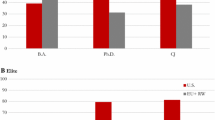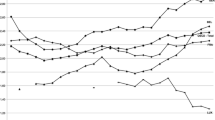Abstract
Europe has a long history as a global center of scientific research, but not all European regions are alike. Regions such as Île de France and the corridor that stretches from Cambridge to Oxford via London produce a disproportionate share of Europe’s science output. An econometric analysis sheds light on the factors that explain the spatial distribution of European science. One result is that the regional volume of Web of Science publications depends on the regional number of researchers in higher education institutions. This is however not the only cause of high output. Universities and their surrounding regions are slowly evolving institutional structures. Some regions host universities that are more than 500 years old. A second key result is that an increase in the age of a region’s oldest university is associated with greater output, other things being equal. Third, interregional accessibility via road, rail, and air networks is important for small regions, but not for large ones. Conversely, regional high-tech R&D employment is important for large but not for small regions.



Similar content being viewed by others
Notes
On average the OECD countries spent 2.2% of GDP on R&D in the 2008 to 2011 period (OECD Science and Technology Indicators 2012, see Andersson et al. 2015a)
These results refer to regions that have at least one fractionalized publication. The results were similar when we included outliers in the regressions.
The U.S. data refer to Metropolitan Statistical Areas (MSAs) and the Chinese data to prefectures. European NUTS2 regions are sometimes comparable to U.S. MSAs and/or Chinese prefectures (e.g. Ile de France and other French regions), but sometimes they are smaller (e.g. regions in southeast England).
The transmission of knowledge depends on social as well as geographical proximity. In studies of scientific co-authorships, it is common to find a substantially greater volume of co-authorships than is accounted for by regional research volumes and spatial distance if co-authors share a native language or a past colonizing country (Andersson and Persson 1993; Andersson 2001). Likewise, the popular expression “the wrong side of the tracks” refers to the social barriers that are often associated with a railroad track or freeway in U.S. metropolitan areas. In contrast, we deem it unlikely that university or industry scientists residing in the same geographical region would experience social barriers that are high enough to reduce scientific knowledge dissemination within the same occupational group in the same region.
The vintage effect on scientific productivity, for which we use the age-of-oldest-university variable, is in reality more complex. Hence our variable is akin to a multidimensional index which reflects factors such as path dependency, changes in remuneration and other funding, and a wide array of relevant political influences. The age variable is thus a compact proxy for the consequences of all these different efficiency factors. It corresponds to the time parameter in economic growth models.
Following the approach of Bonaccorsi and Daraio (2005) and Grossetti et al. (2016), we also estimated a less elaborate function with only research personnel in universities, industrial R&D employment, and regional per capita income as explanatory variables (see Tables 9, 10 in “Appendix 2”). However, the income variable may be associated with endogeneity problems. Using slowly changing variables is therefore preferable. Accessibility and age of the oldest university are examples of such slowly changing variables. Both variables change by much less than 1% per year and are independent of scientific output fluctuations. For the interested reader, we provide functions for all regions in the two time periods with income measured as a 3-year moving average (Tables 11, 12) and publications per HEI researcher as a function of the age of the oldest university.
Statistical significance thresholds are different depending on whether there is an expected sign or not. If there is an expected sign associated with the variable, we use one-tailed tests. If there is no expected sign, two-tailed tests are appropriate.
The accessibility variable consists of three components: “population living in surrounding regions weighted by travel time along motorways,” “population living in surrounding regions weighted by travel time along railways,” and “daily number of passenger flights accessible within 90 [minutes’] drive” (Annoni and Dijkstra 2013, p. 46).
This finding is consistent with the conclusion that governance quality is more important than research expenditures for the attraction and retention of highly cited researchers (cf. Bauwens et al. 2011).
We use the median value of the total population as the cut-off point for distinguishing between small and large NUTS2 regions. As the majority (193 out of 227) of the NUTS2 regions experienced population growth during our sample period, using the median value instead of a static population threshold can better accommodate the dynamic nature of our panel data.
References
Abbott, M., & Doucouliagos, H. (2004). Research output of Australian universities. Education Economics,12(3), 251–265.
Adams, J. D., & Griliches, Z. (1998). Research productivity in a system of universities. Annals of Economics and Statistics,49–50, 127–162.
Aghion, P., Dewatripont, M., Hoxby, C., Mas-Colell, A., Sapir, A., & Jacobs, B. (2010). The governance and performance of universities: evidence from Europe and the US. Working Paper, Centre for Economic Policy Research, Centre for Economic Studies, CESifo Group, Maison des Sciences de l’Homme.
Andersson, Å. E. (1985). Creativity and regional development. Papers of the Regional Science Association,56(1), 5–20.
Andersson, Å. E., & Andersson, D. E. (2017). Time, Space and Capital. Cheltenham, UK: Edward Elgar.
Andersson, Å. E., Andersson, D. E., Hårsman, B., & Daghbashyan, Z. (2015a). Complexity, scientific creativity and clustering. In K. Kourtit, P. Nijkamp, & R. R. Stough (Eds.), The rise of the city: Spatial dynamics in the urban century (pp. 15–32). Cheltenham, UK: Edward Elgar.
Andersson, Å. E., Andersson, D. E., & Matthiessen, C. W. (2013). Öresundsregionen: den dynamiska metropolen. Stockholm, Sweden: Dialogos.
Andersson, Å. E., & Persson, O. (1993). Networking scientists. Annals of Regional Science,27, 11–21.
Andersson, D. E. (2001). Emerging knowledge networks in Eastern Asia. In D. E. Andersson & J. P. H. Poon (Eds.), Asia-Pacific Transitions (pp. 269–276). Basingstoke, UK: Palgrave Macmillan.
Andersson, D. E., Andersson, Å. E., Hårsman, B., & Daghbashyan, Z. (2015b). Unemployment in European regions: Structural problems versus the Eurozone hypothesis. Journal of Economic Geography,15(5), 883–905.
Angrist, J. D., Imbens, G. W., & Krueger, A. B. (1999). Jackknife instrumental variables estimation. Journal of Applied Econometrics,14(1), 57–67.
Annoni, P., & Dijkstra, L. (2013). EU Regional Competitiveness Index 2013. Luxembourg: Publications Office of the European Union.
Arcaute, E., Hatna, E., Ferguson, P., Youn, H., Johansson, A., & Batty, M. (2015). Constructing cities, deconstructing scaling laws. Journal of the Royal Society Interface,12, 20140745.
Bauwens, L., Mion, G., & Thisse, J.-F. (2011). The resistible decline of European science. Recherches économiques de Louvain,77(4), 5–31.
Bettencourt, L. M. A., Lobo, J., Helbing, D., Kuhnert, C., & West, G. B. (2007). Growth, innovation, scaling, and the pace of life in cities. PNAS,104(17), 7301–7306.
Bonaccorsi, A., & Daraio, C. (2005). Exploring size and agglomeration effects on public research productivity. Scientometrics,63(1), 87–120.
Ciccone, A. (2002). Agglomeration effects in Europe. European Economic Review,46, 213–227.
David, Q. (2013). Determinants of research production at top US universities. The BE Journal of Economic Analysis & Policy,14(1), 81–109.
Dhaene, G., & Jochmans, K. (2015). Split-panel jackknife estimation of fixed-effect models. Review of Economic Studies,82(3), 991–1030.
European Science Foundation. (2017). Career tracking survey of doctorate holders: Project report. Strasbourg, France: European Science Foundation.
Franzoni, C., Scellato, G., & Stephan, P. (2011). Changing incentives to publish. Science,333, 702–703.
Griliches, Z. (1995). R&D and productivity: econometric results and measurement issues. In: Stoneman, P. (Ed.), Handbook of the Economics of Innovation and Technical Change. Oxford, UK: Blackwell.
Grossetti, M., Eckert, D., Gingras, Y., Jégou, L., Larivière, V., & Milard, B. (2013). Cities and the geographical de-concentration of scientific activity: A multilevel analysis of publications (1987–2007). Urban Studies,51(10), 2219–2234.
Grossetti, M., Eckert, D., Maisonobe, M., & Tallec, C. (2016). Four commonly held beliefs about the geography of scientific activities. In R. Shearmur, C. Carrincazeaux, & D. Doloreux (Eds.), Handbook on the Geographies of Innovation (pp. 223–240). Cheltenham, UK: Edward Elgar.
Hahn, J., & Moon, H. R. (2006). Reducing bias of MLE in a dynamic panel model. Econometric Theory,22, 499–512.
Hahn, J., & Newey, W. (2003). Jackknife and analytical bias reduction for nonlinear panel models. Cemmap Working Paper No. CWP17/03.
Harzing, A. W., & Giroud, A. L. A. (2014). The competitive advantage of nations: An application to academia. Journal of Infometrics,8(1), 29–42.
Henderson, J. V., Kuncoro, A., & Turner, M. (1995). Industrial development in cities. Journal of Political Economy,103(5), 1067–1090.
Henderson, J. V. (2003). Marshall’s scale economies. Journal of Urban Economics,53, 1–28.
Hollingsworth, R. (2007). The role of institutions and organizations in shaping radical scientific innovations. In L. Magnusson & J. Ottosson (Eds.), The evolution of path dependence (pp. 129–155). Thousand Oaks, CA: Sage Publications.
Jacobs, J. (1970). The economy of cities. New York: Vintage.
Kirk, K., & Cotton, C. (2012). The Cambridge phenomenon: 50 years of innovation and enterprise. London: Third Millennium Information.
Marshall, A. (1920). Principles of economics. London, UK: Macmillan.
Matthiessen, C. W., & Schwarz, A. W. (1999). Scientific centres in Europe: An analysis of research strength and patterns of specialisation based on bibliometric indicators. Urban Studies,36(3), 453–477.
Moretti, E. (2012). The New Geography Of Jobs. New York, NY: Houghton Mifflin Harcourt.
Nomaler, Ö., Frenken, K., & Heimeriks, G. (2014). On scaling of scientific knowledge production in U.S. metropolitan areas. PLoS ONE,9(10), e110805.
OECD. (2015). Education at a glance 2015: OECD indicators. Paris: OECD Publishing. https://doi.org/10.1787/eag-2015-en.
OECD. (2019). Education at a glance 2019: OECD indicators. Paris: OECD Publishing. https://doi.org/10.1787/f8d7880d-en.
Pastor, J.M., & Serrano, L. (2016) The research output of universities and its determinants: Quality, intangible investments, specialisation and inefficiencies. EU SPINTAN Project: Smart Public intangibles. Working Paper Series No. 5.
Payne, A. A., & Siow, A. (2003). Does federal research funding increase university research output? Advances in Economic Analysis & Policy,3(1), 1–24.
Persson, O., & Beckmann, M. (1995). Locating the network of interacting authors in scientific specialties. Scientometrics,33(3), 351–366.
Pumain, D., Paulus, F., Vacchiani-Marcuzzo, C., & Lobo, J. (2006) An evolutionary theory for interpreting urban scaling laws. Cybergeo: Revue européenne de géographie, N° 343.
Roberge, G., Picard-Aitken, M., Côté, G., Lefebvre, C., Archambault, E., Campbell, D., et al. (2014). Country and regional scientific production profiles. Brussels, Belgium: European Commission.
Rosenthal, S. S., & Strange, W. C. (2004). Evidence on the nature and sources of agglomeration economies. In J. V. Henderson & J.-F. Thisse (Eds.), Handbook of regional and urban economics (Vol. 4, pp. 2219–2271). Amsterdam, Netherlands: Elsevier.
Stephan, P. E. (1996). The economics of science. Journal of Economic Literature,34(3), 1199–1235.
Tabellini, G. (2005). Culture and institutions: Economic development in the regions of Europe. CeSIFO Working Paper No. 1492. Munich, Germany: Center for Economic Studies.
Times Higher Education Supplement. (2019). World University Ranking 2020. https://www.timeshighereducation.com/world-university-rankings/2020/world-ranking#!/page/0/length/25/sort_by/rank/sort_order/asc/cols/stats. Accessed December 14, 2019.
Tikhonov, A. N. (1952). Systems of differential equations containing small parameters in the derivatives. Matematicheskii sbornik,73(3), 575–586.
Tikhonov, A. N., Vasil’eva, A., & Sveshnikov, G. (1985). Differential equations. Berlin: Springer.
Tychonoff, N. (1930). Ueber die topologische Erweiterung von Räumen. Mathematische Annalen,102(1), 544–561.
Acknowledgements
We would like to thank Vardan Hovsepyan for allocating some of his substantial computer programming skills to our project and for his help in the time-consuming task of allocating publications to NUTS2 regions. In addition, we would like to thank two anonymous referees for numerous constructive suggestions and critical comments. We think that the three of them had the joint effect of helping us improve the quality and persuasiveness of this paper.
Author information
Authors and Affiliations
Corresponding author
Appendices
Appendix 1: Residual mapping
Appendix 2
Appendix 3
Rights and permissions
About this article
Cite this article
Andersson, D.E., Andersson, Å.E., Hårsman, B. et al. The geography of science in 12 European countries: a NUTS2-level analysis. Scientometrics 124, 1099–1125 (2020). https://doi.org/10.1007/s11192-020-03510-9
Received:
Published:
Issue Date:
DOI: https://doi.org/10.1007/s11192-020-03510-9




